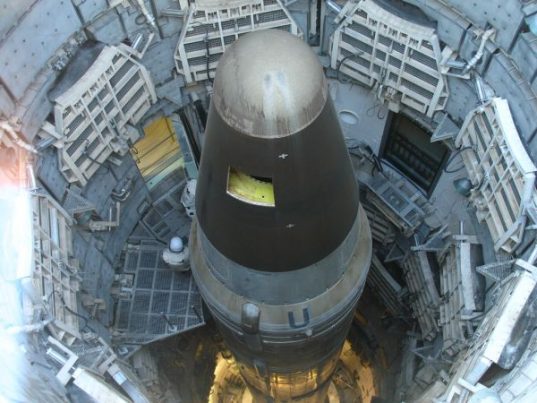
Russia’s nuke buildup challenging Obama’s order to reduce role of atomic weapons in U.S. arsenal
Tuesday, September 22, 2015 by usafeaturesmedia
http://www.nationalsecurity.news/2015-09-22-russias-nuke-buildup-challenging-obamas-order-to-reduce-role-of-atomic-weapons-in-u-s-arsenal

(NationalSecurity.news) President Barack Obama wants to reduce America’s nuclear arsenal, largely for ideological reasons. He opposes nuclear weapons in general and has made that clear through language and policy throughout his presidency.
But the other great nuclear powers around the world are not only not reducing their nuclear arsenals, but they are expanding and modernizing nuclear forces at pace not seen since the Cold War.
So we have a dichotomy – it is Obama policy to reduce the number of U.S. nuclear weapons while slowing modernization at a time when our potential enemies are upping their inventories and modernizing their delivery systems.
One of those nations is, of course, Russia. As reported by longtime Washington Times defense correspondent Bill Gertz, Obama’s 2013 decision to reduce the role of nuclear weapons in American military and defense policies is directly being challenged by Moscow’s large-scale buildup of nuclear forces, along with Russian President Vladimir Putin’s revised nuclear doctrine and recent threats to use such weapons.
“The U.S. guidance was outlined in a 2013 White House order called Presidential Policy Directive-24, which calls for reducing the role of U.S. nuclear weapons in national security strategy and maintaining deterrence with smaller nuclear forces,” Gertz wrote.
In a report to Congress the Pentagon says the administration is seeking “the peace and security of a world without nuclear weapons,” which – at this juncture – is just wishful thinking and not very practical.
At the same time, however, the U.S. views the safety, security and effectiveness of the nuclear arsenal as a deterrent that has to be maintained “as long as nuclear weapons exist.”
A flaw in the administration’s guidance was outlined in PDD-24, which is classified. The directive says that a “key part” of the new guidance is a more benign global security environment, but that is not the reality in today’s world. Nuclear threats by countries like Russia, North Korea and Iran are a constant, and China’s nuclear buildup is also a new concern.
And the nuclear threat from Russia has also become more serious since Obama signed his order.
“The 2013 order erroneously states that despite differences, ‘Russia and the United States are no longer adversaries and the prospects of a military confrontation between us have declined dramatically,’” Gertz wrote, citing the document.
That statement has become less accurate following Russia’s annexation of Crimea and its continuing efforts to destabilize eastern Ukraine, as well as Moscow’s announced threats against eastern European nations.
Russia’s newly aggressive posture was also noted recently in statements by senior military and defense leaders. Marine Corps Gen. Joseph Dunford, nominated to become the next chairman of the Joint Chiefs of Staff, told the Senate Armed Services Committee in July, “If you look at their behavior, it’s nothing short of alarming.”
Some days later, NATO commander Gen. Philip Breedlove said Russian revanchism has undermined stability throughout the region. Russia “is a nation that possesses a pretty vast nuclear inventory, and talks about the use of that inventory very openly,” he said on PBS. “And they talk about using, as a matter of course, nuclear weapons. For that reason, these senior leaders, I believe, see that as a major threat.”
In addition, Ash Carter, the U.S. defense secretary, said what has changed under Putin is that Russia is much more an “antagonist,” and that has forced the U.S. to adjust its military posture in order to deter Moscow and support our allies.
The changed security environment has created a dilemma for the Defense Department. Obama’s guidance anticipates a much different scenario than what is actually occurring, and as such, the Pentagon and U.S. Strategic Command, the war-fighting command in charge of preparing for a nuclear conflict, are said to be preventing full implementation of the order, Gertz wrote. The order calls for an annual review but so far, according to defense officials, no review has been undertaken.
Because the White House’s guidance anticipated a different scenario than what is actually occurring, the Pentagon and the U.S. Strategic Command, the war-fighting command in charge of preparing for a nuclear conflict, are said to be preventing full implementation of the plan. The presidential order requires an annual review of the security environment, but defense officials say so far no review has been carried out.
Dunford is likely to do so, however, and an adjustment of the order will probably follow, defense officials told Gertz.
Follow NationalSecurity.news editor Jon E. Dougherty on Twitter and Google+.
See also:
Tagged Under:






